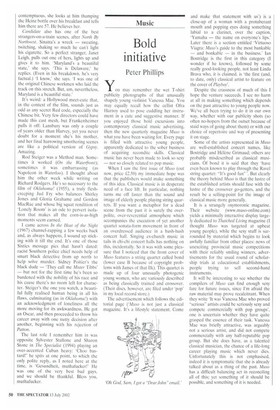Music
Bold initiative
Peter Phillips
You may remember the wet T-shirt publicity photographs of that unusually shapely young violinist Vanessa Mae. You may equally recall how the cellist Ofra Harnoy used to pose cuddling her instrument in a cute and suggestive manner. If you enjoyed those bold excursions into contemporary classical music advertising, then the new quarterly magazine Muso is what you have been waiting for. Every page is filled with attractive young people, apparently dedicated to the sober business of acquiring recondite skills. Classical music has never been made to look so sexy — nor so closely related to pop music.
When I saw the first issue of Muso (out now, price £2.50) my immediate hope was that the publishers would make something of this idea. Classical music is in desperate need of a face lift. In particular, nothing turns me off faster than the sound and image of elderly people playing string quartets. If you want a metaphor for a dead scene from the past it is surely the overpolite, over-reverential atmosphere which accompanies the execution of yet another quartet sonata-form movement in front of an overdressed audience in a hush-hush concert hall. Singing ex-church music in tails in chi-chi concert halls has nothing on this, incidentally. So it was with some pleasure that I noticed that the front cover of Muso features a string quartet called bond (lower case B because of copyright problems with James of that Ilk). This quartet is made up of four unusually photogenic young women, who are variously described as being classically trained and crossover. (Their discs, however, are filed under 'pop' in my local record store.) The advertisement which follows the editorial page (`Muso is not just a classical magazine. Ifs a lifestyle statement. Come , and make that statement with us') is a close-up of a woman with a protuberant mouth and popping eyes doing something labial to a clarinet, over the caption, 'Yamaha — the name on everyone's lips.' Later there is a section entitled 'Virtuoso Viagra: Muso's guide to the most bankable — and bonkable — in the business.' Ian Bostridge is the first in this category (I wonder if he knows), followed by some really good-looking people, not least Linda Brava who, it is claimed, is 'the first (and, to date, only) classical artist to feature on the cover of Playboy'.
Despite the crassness of much of this I hope the venture succeeds. I see no harm at all in making something which depends on the past attractive to young people now. We've all been trying to do it in our own way, whether with our publicity shots (so often no-hopers from the outset because of staid ways of going about them) or with our choice of repertoire and way of presenting it on stage.
Some of the artists represented in Musa are well-established concert names, like Bostridge and Helene Grimaud; others are probably misdescribed as classical musicians. Of bond it is said that they 'have even been known to play through the Ravel string quartet: "It's good fun" '. But clearly the theory behind Muso is that the lustre of the established artists should fuse with the lustre of the crossover go-getters, and the result be a selling-point for the image of classical music more generally.
It is a strangely oxymoronic magazine. Their website (www.muso-online.com) yields a minimally interactive display largely dedicated to Thatched Living magazine (I thought Muso was targeted at upbeat young people), while the sexy stuff is surrounded by material which begins to look awfully familiar from other places: news of unexciting provincial music competitions with their reliably smiling winners, advertisements for the usual round of scholarship trials at educational establishments, people trying to sell second-hand instruments.
It will be interesting to see whether the compilers of Musa can find enough sexy fare for future issues, since I'm afraid the raw material may prove recalcitrant. When they write 'It was Vanessa Mae who proved "serious" artists could be seriously sexy and compete commercially with pop groups', one is uncertain whether they have quite grasped the essence of their task. Vanessa Mae was briefly attractive, was arguably not a serious artist, and did not compete commercially with any half-reputable pop group. But she does have, as a talented classical musician, the chance of a life-long career playing music which never dies. Unfortunately this is not emphasised, indeed it is symptomatic that she is already talked about as a thing of the past. Muso has a difficult balancing act in reconciling all of this; yet something of it should be possible, and something of it is needed.


































































 Previous page
Previous page